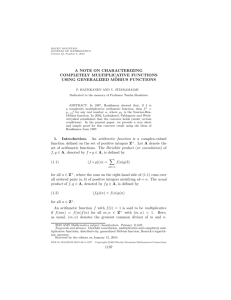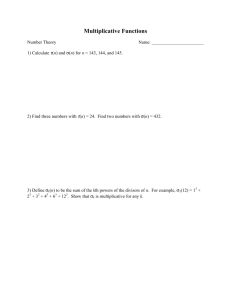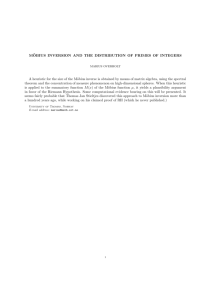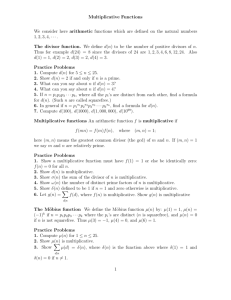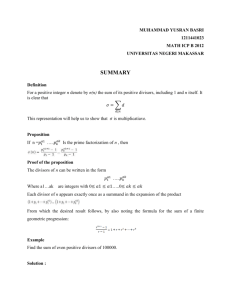UNITARY PRODUCTS AGAIN 1. Introduction The Dirichlet product
advertisement
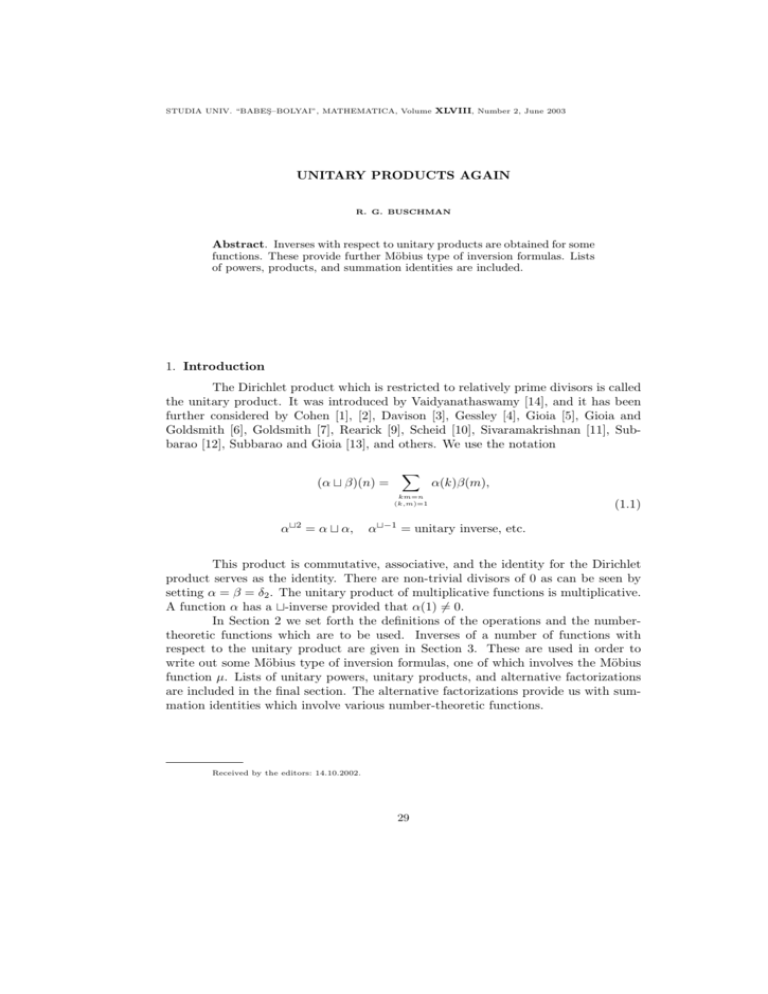
STUDIA UNIV. “BABEŞ–BOLYAI”, MATHEMATICA, Volume XLVIII, Number 2, June 2003 UNITARY PRODUCTS AGAIN R. G. BUSCHMAN Abstract. Inverses with respect to unitary products are obtained for some functions. These provide further Möbius type of inversion formulas. Lists of powers, products, and summation identities are included. 1. Introduction The Dirichlet product which is restricted to relatively prime divisors is called the unitary product. It was introduced by Vaidyanathaswamy [14], and it has been further considered by Cohen [1], [2], Davison [3], Gessley [4], Gioia [5], Gioia and Goldsmith [6], Goldsmith [7], Rearick [9], Scheid [10], Sivaramakrishnan [11], Subbarao [12], Subbarao and Gioia [13], and others. We use the notation (α t β)(n) = X α(k)β(m), km=n (k,m)=1 αt2 = α t α, (1.1) αt−1 = unitary inverse, etc. This product is commutative, associative, and the identity for the Dirichlet product serves as the identity. There are non-trivial divisors of 0 as can be seen by setting α = β = δ2 . The unitary product of multiplicative functions is multiplicative. A function α has a t-inverse provided that α(1) 6= 0. In Section 2 we set forth the definitions of the operations and the numbertheoretic functions which are to be used. Inverses of a number of functions with respect to the unitary product are given in Section 3. These are used in order to write out some Möbius type of inversion formulas, one of which involves the Möbius function µ. Lists of unitary powers, unitary products, and alternative factorizations are included in the final section. The alternative factorizations provide us with summation identities which involve various number-theoretic functions. Received by the editors: 14.10.2002. 29 R. G. BUSCHMAN 2. Definitions The domain of definition of number-theoretic functions is, as usual, taken to be the positive integers. We use the following notations for operations. (α · β)(n) = α(n)β(n) X (α ∗ β)(n) = (pointwise product) α(k)β(m) (Dirichlet product) km=n (αβ)(n) = X α(k)β(n) (lcm-product) (2.1) [k,m]=n α∗2 = α ∗ α, α2 = α · α, α2 = αα, α∗−1 = Dirichlet inverse of α, etc. etc. All of these product are associative, commutative, and there are identity elements (ν0 · α) = α, ∗ α = α, α = α, for all α. (2.2) No non-trivial divisors of zero exist for the ∗-product, but they do exist for the other products. The set of number theoretic functions which satisfy the condition α(1) 6= 0 forms a group under Dirichlet multiplication. In this group α ∗ β is a multiplicative function if both α and β are multiplicative; that is, the multiplicative functions form a subgroup; see Niven and Zuckerman [8]. Some properties of all of these multiplications can be found in Scheid [10]. We use for the identity, (n) = 1 if n = 1, and = 0 otherwise. We choose the symbols ν0 for the multiplicative identity for the pointwise product, ν0 = 1 for all n; νk (n) = nk ; κ(n) for the number of square-free divisors of n, κ(n) = 2ω(n) ; λ for Liouville’s function, λ(n) = (−1)Ω(n) ; µ for the Möbius function, µ(n) = 0 if p2 |n, and = (−1)ω(n) otherwise. Let τk (n) = the number of ways of writing n as a product of k factors, τ2 = τ , σk (n) = the sum of the k th powers of the divisors of n, σ1 = σ; ω(n) = the number of prime divisors of n; and Ω(n) = the total number of divisors of n. In addition we let δk (n) = 1 if n = k, = 0 otherwise; generalized ∗−1 ∗−1 ∗−1 D M Möbius functions µC , µC , µD , 0 = µ; µk = τk 1 = µ; µk = Pk k = (µ · νk ) = νk M k µ1 = µ, Jk = νk ∗ µ Jordan’s totient, J1 = φ; Pk (n) = 1 if n = m , = 0 otherwise, P2 = P , the characteristic function for squares; Qk (n) = 1 if n is k th -power-free, = 0 otherwise, Q2 = Q = µ2 ; and S(n) = the number of divisors of n2 . In our work the superscript symbol † is used to denote the unitary analogs of our previously defined number-theoretic functions, instead of the more customary symbol ∗ . This is done in order to avoid possible confusion with ∗-multiplication. We define some of the more important analogous functions which occur naturally in connection with the t-product. µ† = (−1)ω = ν0t−1 . µ†k = Pkt−1 , 30 µ†1 = µ† . (2.3) (2.4) UNITARY PRODUCTS AGAIN σk† (n) = sum of the k th powers of the unitary divisors of n, σ0† τk† (n) σ1† † =τ , (2.5) † =σ . = ν0tk (n) = (µ† )t−k (2.6) † τ−1 = µ† , τ0† = , τ1† = ν0 , τ2† = τ † = κ. † M The function (µ† )tk is the unitary analog of µD k ; µk , of µk . For k > 0, the † function τk counts the number of ways of expressing n as a product of k factors which are relatively prime in pairs. 3. Inverses and inversion formulas The Möbius inversion formula (for sums over divisors) is given by α = ν0 ∗ β ⇔ β = µ ∗ α. (3.1) Since the t-inverse of ν0 is µ† , an analog of the Möbius inversion formula is α = ν0 t β ⇔ β = µ† t α. (3.2) A generalization follows from the definitions. α = τk† t β ⇔ β = (µ† )tk t α. (3.3) Some of the t-inverses have been derived. † κt−1 = (µ† )t2 = τ−2 . (3.4) Pkt−1 = µ†k . (3.5) t−1 = µ. (3.6) t−1 = (κ · Q). (3.7) t−1 = (Q · S). (3.8) Q (κ · µ) (µ · S) (νk · Q)t−1 = µC (3.9) k. These lead to a number of further inversion formulas. As one example, an alternative analog for the Möbius inversion which retains µ, instead of ν0 , in the formulas reads α = Q t β ⇔ β = µ t α. (3.10) Some other examples follow. α = Pk t β ⇔ β = µ†k t α. (3.11) α = (κ · µ) t β ⇔ β = (κ · Q) t α. α = (µ · S) t β ⇔ β = (Q · S) t α. (3.12) (3.13) α = (νk · Q) t β ⇔ β = µC (3.14) k t α. The completely t-multiplicative functions are simply the ∗-multiplicative functions. Hence, if ξ is ∗-multiplicative, we have the three important properties of completely multiplicative functions, see Scheid [10]. ξ · (α t β) = (ξ · α) t (ξ · β). (3.15) ξ t−1 = (ξ · µ† ). (3.16) 31 R. G. BUSCHMAN ξ tr = (ξ · τk† ). Further, if η is multiplicative and ξ has a t-inverse, then (η · ξ)t−1 = (η · ξ t−1) . (3.17) (3.18) Hence for any ∗-multiplicative function η we have the general inversion formula α = η t β ⇔ β = (η · µ† ) t α. (3.19) We note that (α ∗ β)(n) and (α t β)(n) are equal at squarefree n. Since Q(n) is ∗-multiplicative and equals 0 except at squarefree n, we have (α ∗ β) · Q = (α · Q) t (β · Q). (3.20) The operation of pointwise multiplication of functions by Q can be seen to map the ∗-products into the t-products which are evaluated at squarefree numbers. This may seem to be of limited value, but it does give us a way to build up another list from any list of Dirichlet products. From the known result λ ∗ ν0 = P and evaluation of the pointwise products, we can thus show that µ t Q = , which leads to the Möbius inversion formula (3.10). Formulas (3.16) and (3.20) are a source for various t-inverses. For completely ∗-multiplicative functions Vaidyanathaswamy [14] had obtained a relation which connects four different products. (α t β) ∗ (α · β) = (αβ). (3.21) Two additional identities of Scheid [10] are of interest, since they also provide connections among various products. The first of these is a corollary of his formula for a product of n-factors; compare with (2.8). For ∗-multiplicative functions ξ ∗ (α t β) = (ξ ∗ α) t (ξ ∗ β) t (µ† · ξ). (3.22) (α · (β ∗ ν0 )) t (β · (α ∗ ν0 )) = (α · β) ∗ (αβ). (3.23) 4. Lists of Products Since not many explicit unitary products appear in the literature, a number of examples have been obtained. First, a few t-powers are known. † κtr = τ2r . tr (4.1) µD r . µ = (4.2) Q = (τr · Q). (4.3) Many special cases of (3.21)-(3.23) are themselves of interest. Several of the special cases resulting from (3.20) have been included in the list. tr α t = α. (4.5) κ t µ = ν0 . (4.6) κ t ν0 = † κt τk† = † † τk+2 . † κtφ =σ . λt2 = (κ · λ). µ t Q2k = . 32 (4.4) τ3† . (4.7) (4.8) (4.9) (4.10) UNITARY PRODUCTS AGAIN µ t (µ · τ ) = (µ · S). µ t (τ · Q) = Q. µC k t (σk · Q) = Q. µC k t (Jk · Q) = µ. ν0t2 = κ. (4.11) (4.12) (4.13) (4.14) (4.15) ν0tk = τk† . (4.16) σk† . (4.17) ν0 t µ = . ν0 t φ† = ν1 . (4.18) (4.19) ν0 t Jk† = νk . (4.20) ν0 t νk = † ν0 t τk† = † † τk+1 . † (4.21) ν1 t µ = φ . (4.22) Jk† . νk t µ = Q t (νk · Q) = (σk · Q). Q t (κ · µ) = µ. Q t (κ · Q) = (S · Q). Q t (µ · S) = (µ · τ ). Q t (Jk · Q) = (νk · Q). (κ · Q) t (µ · S) = µ. (µ · σk ) t (νk · Q) = µ. (µ · Jk ) t (νk · Q) = Q. (4.23) (4.24) (4.25) (4.26) (4.27) (4.28) (4.29) (4.30) (4.31) µ† t σk† = νk . (4.32) † † µ t τk† = τk−1 . † † φ = (ν1 · σk−1 ) = (νk † † † † σk† t (4.33) · † σ1−k ). (4.34) τ tφ =σ . (4.35) A few examples are presented of mixed products which involve both the Dirichlet and the unitary results. Since σk† has a known Dirichlet series generating function, some Dirichlet products which involve it can be obtained. λ ∗ (µ t (τ · Q)) = . † † ν1 t (ν1 µ ) = φ . (νk t νm ) ∗ σk+m = (σk · σm ). (4.36) (4.37) (4.38) † νk ∗ νm ∗ σk+m = (σk · σm ). (4.39) Alternative factorizations can be interpreted as summation identities. Many examples exist; we list a few of them. λ2 = λt2 ∗ ν0 . (4.40) ν0 νk = νk ∗ σk† . (4.41) νk t † σm = t2 P ∗P νm t σk† . 2 =P . (4.42) (4.43) 33 R. G. BUSCHMAN In the spirit of Liouville’s summation identities, (4.42) and (4.43) can be rewritten, respectively, X X † νk (r)σm (s) = νm (r)σk† (s), (4.44) rs=n (r,s)=1 X X hj=n km=h (k,m)=1 rs=n (r,s)=1 X P (j)P (k)P (m) = P (k)P (m). (4.45) [k,m]=n References [1] E. Cohen, Arithmetic functions associated with the unitary divisors of an integer, Math. Z. 74(1960), 66-80. [2] E. Cohen, Unitary products of arithmetic functions, Acta Arithmetica 7(1961), 29-38. [3] T. M. K. Davison, On arithmetic convolutions, Canad. Math. Bull. 9(1966), 287-296. [4] M. D. Gessley, A generalized arithmetic convolution, Amer. Math. Monthly 74(1967), 1216-1217. [5] A. A. Gioia, The K-product of arithmetic functions, Canad. J. Math. 17(1965), 970-976. [6] A. A. Gioia and D. L. Goldsmith, Convolutions of arithmetic functions over cohesive basic sequences, Pacific J. Math. 38(1971), 391-399. [7] D. L. Goldsmith, A generalized convolution for arithmetic functions, Duke Math. J. 38(1971), 279-283. [8] I. Niven and H. S. Zuckerman, An Introduction to the Theory of Numbers, Wiley, New York, (1980). [9] D. Rearick, Operators on algebras of arithmetic functions, Duke Math. J. 35(1968), 761-766. [10] H. Scheid, Einige Ringe zahlentheoretischen Functionen, J. Reine Angew. Math. 237(1969), 1-11. [11] R. Sivaramakrishnan, Classical Theory of Arithmetic Functions, Marcel Dekker, New York and Basel, (1989). [12] M. V. Subbarao, On some arithmetic convolutions, The Theory of Arithmetic Functions (Proc. Conf., Western Michigan Univ., Kalamazoo, Mich., 1971) Lecture Notes in Math., 251(1972), 247-271, Springer, Berlin. [13] M. V. Subbarao and A. A. Gioia, Identities for multiplicative functions, Canad. Math. Bull. 10(1967), 65-73. [14] R. Vaidyanathaswamy, The theory of multiplicative arithmetic functions, Trans. Amer. Math. Soc. 33(1931), 579-662. Box 917, Langlois, OR 97450-0917, USA 34
